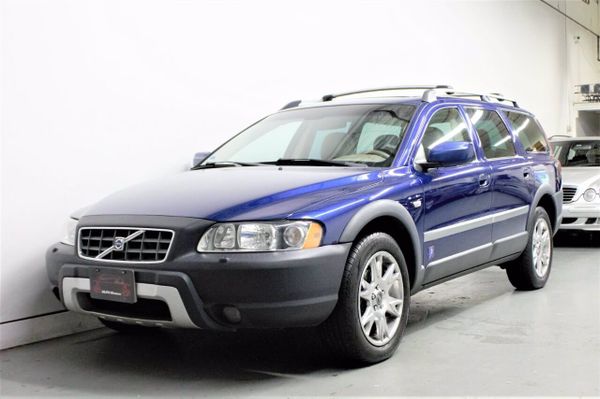

- 2003 volvo crossover cx70 driver#
- 2003 volvo crossover cx70 manual#
- 2003 volvo crossover cx70 full#
- 2003 volvo crossover cx70 plus#
- 2003 volvo crossover cx70 free#
Volvo's Pedestrian Safety system comes with full auto braking, a system brought over from the S60 and XC60. Standard safety items on all XC70s include traction control and anti-skid, a tire pressure monitor, electronic stability control, 4-wheel anti-lock disc brakes with brake assist, a cabin full of airbags and a whiplash protection system. Many of these are bundled into popular packages such as the Convenience Package, which also includes a cargo cover and power folding rear head restraints and the Multimedia Package, which features the rear park assist camera. The T6 AWD adds a power moonroof, leather seating and woodgrain interior trim.Optional on the XC70 are a rear parking aid with back-up camera, HID headlights, rain-sensing wipers, power lift gate, heated seats and navigation. An upgraded 7-inch screen is available, which can display navigation, DVD compatibility and a back-up camera.Other standard features include dual-zone climate control, an auto-dimming rearview mirror, SIRIUS satellite radio, auxiliary audio jack and a USB/iPod audio interface.

2003 volvo crossover cx70 driver#
Volvo's Sensus infotainment system allows driver and passenger to control the car's climate control and stereo system through a 5-inch touchscreen monitor. Standard features on all XC70s include a 40/20/40 split folding rear seat, power windows, locks and mirrors, adjustable steering wheel with integrated audio and cruise control and heated mirrors. Inside, there's attractive materials and smart ergonomics, including Volvo's smart "floating" instrument panel and ultra-slim upright console.
2003 volvo crossover cx70 manual#
A 6-speed Geartronic automatic transmission with manual mode is standard in both models. Two distinct XC70 models are offered: The 3.2 comes powered by a 3.2L inline-6, which produces 240 hp, while the top-of-the-line T6 utilizes a 3.0L turbocharged inline-6 that delivers 300 hp and 325 ft-lb of torque. XC70 wagons come in both all-wheel-drive and front-wheel-drive. In all, this is not exactly a simple job but if you have the right tools it is definitely doable.Volvo discontinued the V70 wagon in 2011, leaving the XC70 as the remaining full-size wagon from the automaker. There is a writeup at volvospeed that discusses replacing the oil return line and has photos showing you what's involved: You have to remove the oil return line at some point, so its up to you whether you do it before or after pulling the turbo.
2003 volvo crossover cx70 free#
Once the bracket is off you may be able to pull the turbo free without removing the return line, and with some wrangling. I lifted mine up, supported with jack stands of course, and removed the bracket that connects the oil intake to the oil return with a 10mm wrench. The angle on some of the nuts is kinda hard to access but not impossible if you have enough patience and small hands.įinally, the turbo oil return line is under the car. For me, I found that the best tool to have is a ratcheting box wrench. The turbo is attached to the exhaust manifold with four 13mm nuts. The exhaust is three bolts, most likely 13mm- this is the rust-colored pipe that connects to the catalytic converter. Once the three lines are removed you then have to disconnect the turbo itself. Some buy new ones, I think its a personal choice. I was able to clean (light sandpaper will do) and re-use mine, but that's up to you.

With all of these lines, do your best to catch and hang on to the copper washers- there are two on each banjo bolt. I found it helpful to loosen the other end of the oil line, which is a 19mm banjo bolt as well, located near the passenger side of the engine. All of these are connected by "banjo" bolts, which are 17mm, and all of them need to come off to remove the turbo. That leaves the following lines to remove- the oil intake and the coolant intake and out lines. Like the intake, it is connected with a radiator-type clamp you can disconnect with a screwdriver. Then, looking at the turbo from above, you disconnect the pipe that enters the top of the turbo and goes over the top of the engine.
2003 volvo crossover cx70 plus#
I attached little labels made of masking tape, plus I took digital photos because my memory is kinda like a sieve on things like this. There are three of these, make a note of how and where they go so you can reinstall them correctly later. Pull it free and then look at the vacuum lines. Its held on by a radiator-hose type clamp that you can unscrew with a long screwdriver. Next you remove the air intake, which is located on the driver's side of the car. In general, what's involved is you have to remove the heat shield covering the turbo, which on my car is held in place by several 12mm bolts, and you have to maneuver it a bit to get it out even after the bolts are free. I haven't done this job on an AWD car, but I know that the position of the rear wheel drive shaft is going to cause you some trouble.


 0 kommentar(er)
0 kommentar(er)
